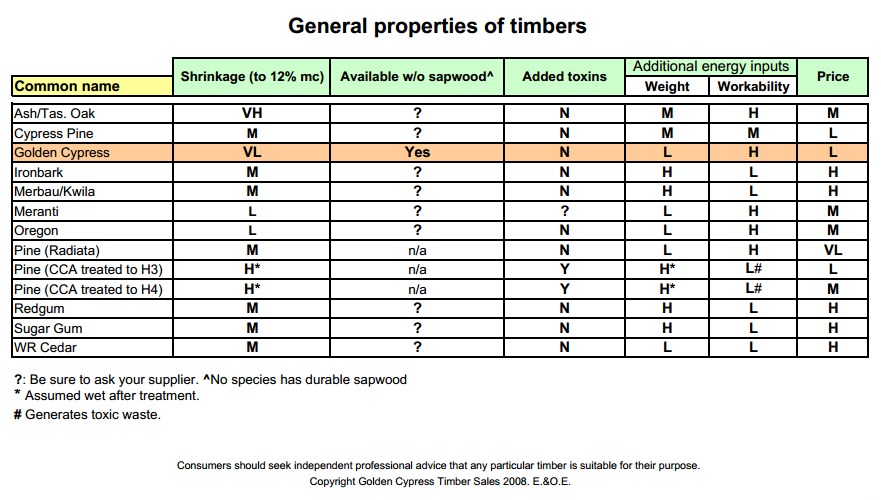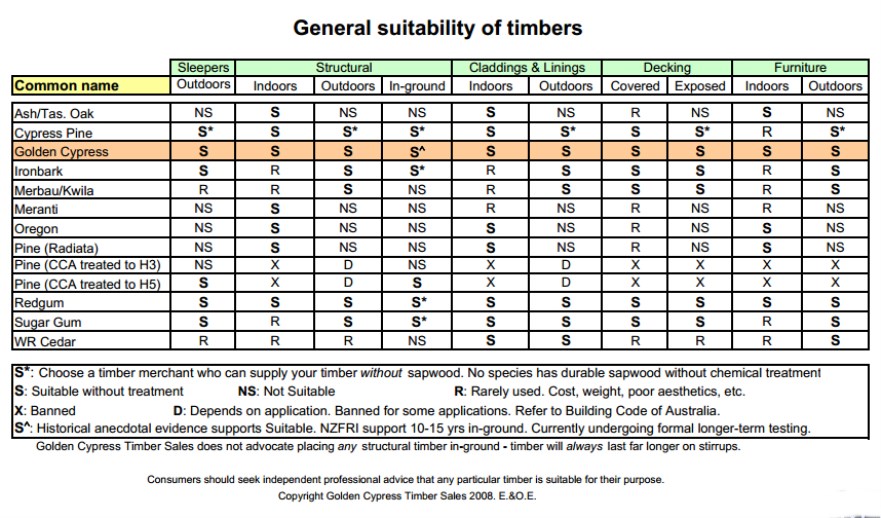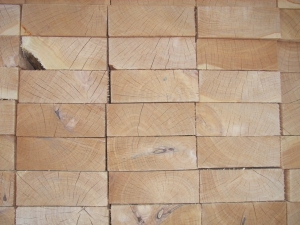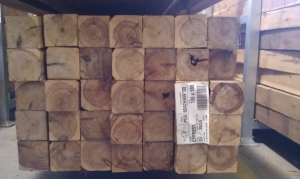Frequently Asked Questions
Yes we do, via our approved contractors who will provide you a custom service.
It’s very important not to cut them down first, then expect them to suit our requirements – please contact us first!
Let us know how many trees you have, a few photos, their location and your phone number, and we’ll get back to you quick-smart.
Grown in southern Australia we salvage old, sick, dangerous or redundant Cypress trees from becoming farm waste. We rescue them from being burned or becoming landfill, thus creating Golden Cypress® the good wood timber.
Golden Cypress timber is predominantly Cupressus macrocarpa – also known as Hesperocyparis macrocarpa – (Monterey Cypress), a native of North America and a true Cypress. Occasionally we include other Cypress variants (eg. macrocarpa hybrids, lawson, lusitanica, etc.) with similar or better properties. Golden Cypress is not “cypress pine” which is an Australian native harvested from State Forests and private land clearing.
We have a growing number of sawmills across south-eastern Australia all supplying to Golden Cypress’s unique grading rules in order to maintain the highest standards possible. Initially, each sawmill must undergo a rigorous pre-qualification process and only the most reliable and most consistent sawmills ever get to join our supply chain. Over the years we’ve certainly rejected far more sawmills than have been approved!
We do, however, love continuing to support small communities so if you think you have the right stuff, contact us for a confidential and no-obligation chat.
The many benefits of using Golden Cypress include its strength, durability, extremely low shrinkage, natural beauty, sustainability and termite resistance. Here are just a few reasons why you should choose Golden Cypress for your next project:
- Strong: Available in Structural Grade F7 – stronger than cypress pine
- Durable: Similar to Jarrah and River Red Gum, expect ~15+ years in-ground (NZFRI)
- Not from native forests: Unlike redgum, cypress pine*, stringybark, “Eco-Select”, etc
- Sustainable: Unlike rainforests, new plantations are being added continually
- Always available in your sizes: And – unlike recycled – no nails, checks or holes!
- Naturally termite resistant: With a naturally delightful and mildly spicy fragrance
- Ethically sourced: Only over-mature, dangerous, sick or redundant trees are harvested
- Chemical free: Unlike the toxins in treated pine for example. No glues to fail either
- Secure supply: Regulatory authorities phased out most treated pine (CCA) in 2006^
- Intrinsically beautiful: Like Kauri, lustrous and golden. Fiddleback is quite common
- Larger sections and longer lengths: For example 250×250. 6.0 meters long
- Exceptionally low shrinkage: Unbeatable 3.3% Tangentally & 1.6% Radially (C.mac)
- Locally grown and milled: Unlike oregon, merbau and cedar, which are imported
- Lighter weight: Makes handling and lifting less tiring. And safer. Lighter than pine!
- Affordable: Contact us for a quote now. You’ll be more than pleasantly surprised
Excellent question. We’ve been banging on to FSC for well over a decade now, despite Golden Cypress having – without challenge – the highest sustainability credentials of any species in Australia.
It’s simple really. We salvage this wood from windbreaks (of exotics) about to be otherwise pushed up burnt and, with minimal external energy input, we convert it straight into sizes and lengths users want and send it straight from the mill to the job. Yes, even more sustainable than plantation timber or recycled timber. More about that is explained elsewhere in these FAQs.
So back to FSC. “Nope sorry. We can’t help you. We don’t have a classification for that. You need to have a forest. Or a plantation.”
So that’s it folks. The world’s most respected timber certification organisation can’t/won’t certify this vast country’s most sustainable source of timber. So sorry you architects, designers and specifiers out there, you can’t get any official Green Star points for using this awesome resource.
Yes, we’re very frustrated too. We’ve been banging on to FSC for change for well over a decade now, alas to no avail.
Let us know your thoughts here. Even better, lobby FSC directly on +613 9329 9984 and ask for the Manager of Policy.
Golden Cypress is available in a variety grades – Landscape, F7 Structural, Premium, seasoned or unseasoned etc. Please contact us to discuss your specific requirements and we’ll match your needs with the most appropriate and economical grade for your specific project.
Golden Cypress timber is available in almost any size to meet your requirements – from 75×50 to 250×250 and larger, we custom cut to order every day. Long lengths to 6 metres or more are available subject to the availability of suitable logs.
We can also saw small sizes (e.g. 25×10) though not in unreasonably long lengths due to the waste created. Minimum order sizes will apply.
Contact us now to discuss your specific needs!
Rescued timber is the most sustainable method of sourcing sawn timber products. Rescued means saving wood from a very low value fate such as burning or becoming landfill. Timber is supplied to size and length as ordered. Very low waste.
Re-used timber is also sustainable because it is used with no additional processing. But re-used timber invariably requires demolition (by someone), some compromises in terms of preferred sizes and some waste in terms of off-cuts due to low grade or over-length.
Recycled timber is essentially re-used timber but with additional processing such as metal-detection, de-nailing, de-bolting, re-sawing to size required and docking. Additional transport steps are usually required. High cost.
Second-hand timber is a general label for re-used timber that hasn’t been re-used yet. Also known as demolition timber.
Salvaged timber is a label used for timber that has either come from salvaged logs (being those logs from windfall trees or senescent trees, like Golden Cypress is) or is timber that has come from a demolition.
Plantation timber is timber that has come from land that was originally under another use (perhaps forest or grazing) and are almost always monocultures of fast-growing varieties grown more for early high volume yield rather than for the true characteristics of the original variety (e.g. durability, tight grain).
Unseasoned timber means timber than has not yet dried to a moisture content matched to its intended environment (this could be 12% for indoor flooring in Victoria and around 16% for outdoor decking in June in Victoria). This does not mean unseasoned timber is unsuitable for any use – it just means you need to be aware of, and maybe detail for, any shrinkage that may occur. Once timber has dried to the moisture content of its environment (called its EMC) it can and will of course continue to swell and shrink as it’s environment changes.
Complicated? A little. What’s important to know is that flooring in particular should always be supplied ‘seasoned’ to an appropriate EMC (usually around 12% for Victoria). Decking on the other hand can be supplied unseasoned but you need to be aware how unseasoned timber shrinks and that is in three ways – 2 ways across the grain (radially and tangentially) and also longitudinally (along the grain). Across the grain Golden Cypress shrinks remarkably little (the average of the radial and the tangential is an extremely low 2.5% from wet green to 12% MC), but like all timbers it can shrink in length. The best way to deal with this is to arriss (plane off the edges) of the cuts that make any butt joins (i.e. accentuating the join). For unseasoned claddings you can mitre the laps or use cover straps. In fact there are many ways to detail a job to use unseasoned material rather than seasoned material.
Structural F7 timber is supplied unseasoned and presents very few problems. In fact Golden Cypress F7 Structural timber is the grade and species of choice for traditional timber framers and mud-brick builders using post and beam frames (e.g. exposed rafters, cathedral ceilings and even load-bearing window frames!), due to its very low shrinkage and stable nature.
Seasoning is often performed in kilns (‘kiln dried’) which in most cases are heated by fossil fuels. Here at Golden Cypress we see no reason to burn fossil fuels when air-drying is a better and more sustainable method – though it can take longer. Despite this, Golden Cypress is actually a very quick drying species in the air; if done correctly a 150 x 25 length of Golden Cypress can dry from green to 12% MC in as little as 6 weeks.
Sapwood is the usually paler band of ‘living’ wood that is just under the bark of a tree. It carries water and nutrients up and down the tree and in all species has a lower durability when exposed to weather. Sapwood positioned horizontally to rain might last 3-7 years, depending on a range of factors. Good builders would position any sapwood away from this exposure.
The other inner wood is known as the heart or the heartwood and in some species, such as Golden Cypress, this wood has a natural durability. And because the trees we harvest at Golden Cypress are senescent, slow-growing, very old trees, the proportion of sapwood present is generally very low. Here’s a picture of the end-grains of a pack of our sleepers – note how little sapwood is present.
On the other hand, here’s a picture of some cypress pine posts being sold at a large hardware retailer. Cypress pine trees have been relentlessly overharvested in NSW and QLD and little remains other than very small diameter fast growing specimens. Notice the prevalence of sapwood.
* For in-ground use we recommend applying Termseal Creofen-10
Our accepted payment methods include direct deposit (preferred), bank cheques, personal cheques and money orders. Instructions for payment will be included on the invoice we email to you once you have confirmed your order.
Yes, to find our more about our stockists (including details about how to become one) visit our Resellers page.





